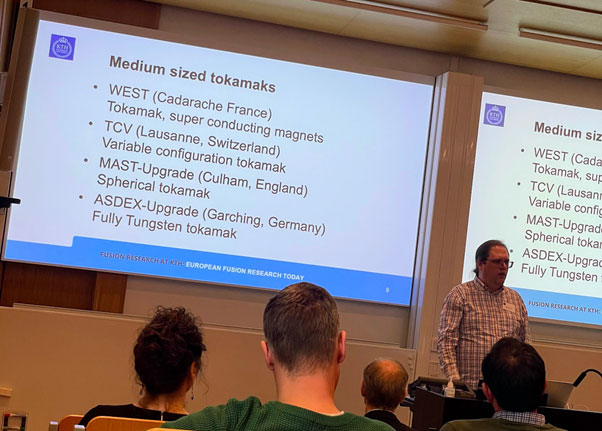First steps taken towards establishing a KTH Fusion Centre

A new research centre is being planned at KTH, which will focus on attracting and supporting Swedish fusion research. The KTH Fusion Centre has an interdisciplinary remit to bring together material research and plasma and fusion physics with adjacent fields.
The KTH Energy Platform organised a seminar in April on the subject of fusion. During the event, plans for the new research facility, KTH Fusion Centre, were presented.
“We see a considerable need to strengthen and broaden competence in the fusion field in Sweden. The KTH Fusion Centre will be a step in that direction and a way to strengthen our international collaborations in the field,” says Thomas Jonsson, Senior Lecturer, Division of Electromagnetic Engineering and Fusion Science, KTH.
Novatron: a key contribution
The Swedish company Novatron Fusion Group AB will provide crucial support for the facility. At the end of 2022, the company unveiled plans for an all-Swedish fusion reactor based on groundbreaking research from KTH alumnus Jan Jäderberg. Construction of the company’s first test facility at KTH is now underway.
“We’ll perform the plasma experiments that support Jan Jäderberg’s research at the facility. The next step is to join the KTH Fusion Centre to help build an environment that can take Swedish fusion research to the forefront of European research,” says Philip von Segebaden, Director of Partnerships at Novatron Fusion Group and Director, KTH Development Office.
The seminar attracted more than 65 registered participants who received a quick course in fusion technology, a look at KTH’s current research in the field, and an overview of fusion research in Europe.
Interdisciplinary fusion
Per Petersson, researcher at the Division of Electromagnetic Engineering and Fusion Science, opened the seminar by giving an overview of current fusion research in Europe. He highlighted KTH’s participation in European consortium Eurofusion.
“Thanks to Eurofusion, we have access to several of the largest experiments that are being conducted in Europe today,” Petersson says.
Eurofusion brings together more than 30 organisations in almost as many countries and has a budget of around 500 million euros. Among the larger projects currently underway is JET in the UK, and several others in France and Germany and elsewhere. Eurofusion has developed a number of working packages, including in materials science, in which it is possible to get involved.

Petersson emphasised that fusion technology is also being developed by a large number of private companies around the world. More than 30 companies are developing various forms of fusion technology, with one of the largest investments being made by Commonwealth Fusion Systems , a spin-off company from Massachusetts Institute of Technology (MIT).
“Novatron Fusion Group is of course one of those private initiatives, which has its own technology that could prove crucial in stabilising plasma in reactors,” Petersson says.
Research in fusion is highly interdisciplinary. Several research projects at KTH involve researchers in fields such as plasma physics, fluid mechanics, nuclear physics, computational physics and materials science.
ITER: the world’s largest fusion project
Next, Svetlana Ratynskaia, professor of plasma physics, gave an update of progress at international research reactor ITER.
ITER is the first fusion reactor capable of producing more power than it requires to operate, and is being built through international collaboration between the US, China, South Korea, India, Japan, Russia and Europe. The reactor is gradually being put into use so that it can be operated using deuterium and tritium around 2035.
“After that, the next step will be the construction of the subsequent DEMO fusion reactor using the knowledge we get from ITER. This will become a demonstration plant for producing electricity from fusion,” says Ratynskaia.
Svetlana Ratynskaia explained that KTH has made a substantive contribution to ITER through its clear co-operation agreements with concrete goals.
“Among other things, we’ve developed tools that were used in the construction work, while researchers at Uppsala University developed various diagnostic methods,” she says.
Two problems that must be addressed before the step can be taken from ITER to DEMO are the actual encapsulation of the plasma in the reactor and the production of tritium. The reactor must become self-sufficient in tritium. On this, Ratynskaia urged participants to support the project through the tenders published on the ITER website .
Ratynskaia also showed a slide that described all the projects that have been undertaken to date to make fusion reactors a reality. The slide was from Richard Pitts, Leader of the Experiments and Plasma Operation Section of ITER, who gave a detailed presentation of ITER at last year’s KTH Energy Dialogue , (click here to watch his presentation).
Workshop in the autumn
A workshop is planned during the autumn with the aim of establishing a plan of action for the KTH Fusion Centre research facility.
“We encourage everyone with project ideas that can be accommodated by the facility to get in touch from today. We’d like to include multiple KTH departments, companies, organisations and authorities that can support Swedish fusion research,” says Pierre Bodin, Research Advisor for Strategic Initiatives, KTH.
The long-term goal is to establish a new research centre with the involvement of Novatron, among others, with its technical capacity and its upcoming test facilities.
“The KTH Fusion Centre is an excellent way to support Swedish fusion research. Novatron’s first experiment will take place in the first half of next year and will focus on confirming our technology and our research. After that, it’ll be time to build the next facility for fusion experiments,” von Segebaden says.
Novatron is already involved in European fusion collaboration projects and is also involved in collaborations through the American Fusion Industry Association.
Text: Magnus Trogen Pahlén

